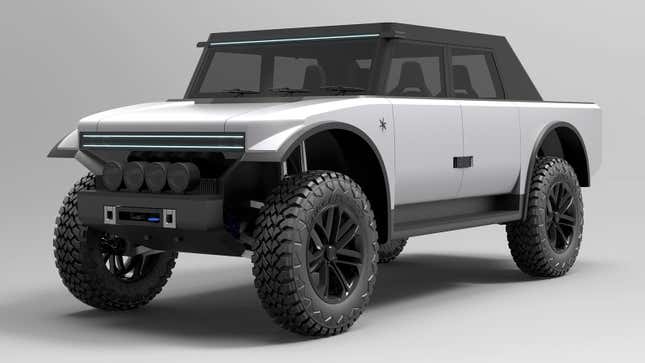
Last week I wrote about the Fering Pioneer, a dual-motor electric off-roader with a diesel range extender and, among other things, body panels made of durable canvas fabric. I had a lot of questions about the merit of a fabric body for the sort of scenarios the Pioneer is designed to tackle. This is an expensive vehicle purportedly built for use in the “remotest areas of the globe,” so surely there was some rationale for the unusual design choice.
I reached out to Fering Technologies, who sent me some answers courtesy of Ben Scott-Geddes, the main dude behind the Pioneer. Before that, he worked under Gordon Murray to create the McLaren F1, and contributed to the SF90 Stradale’s development over at Ferrari.
Scott-Geddes provided a ton of insight as to the rationale behind the fabric body, and while it still doesn’t seem like a perfect solution — not that there’s any such thing — I’m now more convinced it makes sense after hearing the arguments supporting it. Let’s work through his explainer, shall we?
We decided to employ a fabric based outer body skin wherever possible for a number of reasons.
Primarily, it’s to save weight. For the past 100 years, body panels for cars (but not aircraft!) have traditionally been made from materials such as steel, aluminium or composites. This is to allow them to ‘cover’ mechanical systems and communicate a design form.
As the latter is not a priority for us then all we need to do is cover and protect mechanical systems, form a weather proof skin to enclose the cabin and insulate the occupants.
These are the keys: saving mass and prioritizing function over form. Minimizing weight is an indispensable element in EV design, particularly for an extra-long range off-roader like the Pioneer. The truck’s range on pure battery power is only 50 miles, but there’s also the diesel range extender to consider, which takes the form of an 800cc three-cylinder engine. For jobs that cover especially long distances, Fering has proposed extra-long-range diesel tanks able to hold 4,350 miles worth of fuel.

And who cares how it looks? I mean, cars clad in bedsheets will never look right to me, but aesthetics are not a consideration here; making sure components and passengers aren’t exposed to the elements are. Which brings us to Scott-Geddes’ next point:
Fabric allows us to add insulation to whatever level we need, and fabrics provide far more thermal protection than metallic materials. You don’t instinctively climb into a metal box when you are too hot or too cold! Like high-performance hiking materials, our fabric solutions are wind proof and water proof but also breathable, reducing condensation. It means it is considerably easier to maintain a comfortable ambient temperature inside the cockpit when in extreme heat and cold weather. This results in far less energy demand on AC and heating systems which are some of the worst parasitic drains on EV energy sources.
No, I don’t sit in a metal box when I’m cold! This is an excellent point, though maybe if cars and homes were constructed like vacuum-insulated travel mugs, we’d be talking. Anyway, again, when considering keeping weight low and maintaining comfortable cabin temps in extreme climates, the fabric approach sounds like a good compromise.
The fabric materials are also far lighter than any alternative and aero loads are easily managed as this is not a high-speed vehicle - although WWII aircraft used fabric coverings at 400+ mph! Fabrics also allow us the flexibility of a detachable exterior surface which makes changing the colour, cleaning and servicing easy. It also provides ready access to mechanicals and storage underneath.
There is no structural need for strength in the panels as the fabric is stretched over lightweight beam structures which provide the rigidity needed for the vehicle.
I still don’t think it’s going to be easy to clean the Pioneer’s exterior, though the fact the truck’s skin can be removed in pieces (and, hopefully, thrown in a washing machine) adds a degree of modularity, which is neat. Plus, there’s the potential to carry backups.
Fabric would be a terrible choice for, say, a Tesla Model S Plaid. Those “panels” would start flapping in the wind the first time you use launch control. But on a truck like this, never going all that fast but needing to stay light on its feet and be repaired on the fly? There could be something here. I wonder if anyone else will dare try it.
I have a few more questions for Scott-Geddes — namely, whether the canvas is machine washable, how it’s secured to the vehicle’s frame and if Fering will eventually produce conventional hard panels, made of lightweight plastic, carbon-fiber or the like, for buyers that would prefer them. But I’m told Fering’s founder has a hard time putting the wrench down, and he’s “currently hiding somewhere out of phone reach.” Hey — the dude appears to practice what he preaches, that’s got to count for something.